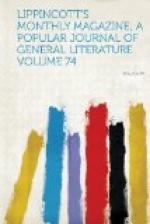As one ascends the Western Ghats shortly after leaving Bombay one has continual occasion to remark the extraordinary resources of modern railway engineering. Perhaps the mechanical skill of our time has not achieved any more brilliant illustrations of itself than here occur. For many miles one is literally going up a flight of steps by rail. The word Ghat indeed means the steps leading up from pools or rivers, whose frequent occurrence in India attests the need of easy access to water, arising from the important part which it plays both in the civil and religious economies of the Hindu. The Ghats are so called from their terraced ledges, rising one above another from the shores of the ocean like the stairs leading up from a pool. In achieving the ascent of these gigantic stairs all the expedients of road-makers have been resorted to: the zigzag, the trestle, the tunnel, the curve, have been pushed to their utmost applications; for five continuous miles on the Thull Ghat Incline there is a grade of one in thirty-seven, involving many trying curves, and on nineteen miles of the Bhore Ghat Incline there are thirty tunnels.
That which gives tone and character to a general view of the interior of a railway-car in traveling is, from the nature of things, the head-covering of the occupants, for it is this which mostly meets the eye; and no one who has traveled in the United States, for example, can have failed to observe the striking difference between the aspect of a car in the South, where the felt slouch prevails, and of one in the North, where the silk hat is more affected. But cars full of turbans! There were turbans of silk, of muslin, of woolen; white turbans, red, green and yellow turbans; turbans with knots, turbans with ends hanging; neat turbans, baggy turbans, preternatural turbans, and that curious spotted silk inexpressible mitre which the Parsee wears.
[Illustration: GONDS.]
Bhima Gandharva was good enough to explain to me the turban; and really, when within bounds, it is not so nonsensical a headdress as one is apt at first to imagine. It is a strip of cloth from nine to twelve inches wide, and from fifteen to twenty-five yards long. They are known, however, of larger dimensions, reaching to a yard in width and sixty yards in length. The most common color is white; next, perhaps, red, and next yellow; though green, blue, purple and black are worn, as are also buff, shot colors and gray, these latter being usually of silk; but this does not exhaust the varieties, for there are many turbans made of cotton cloth printed in various devices to suit the fancies of the wearers.




